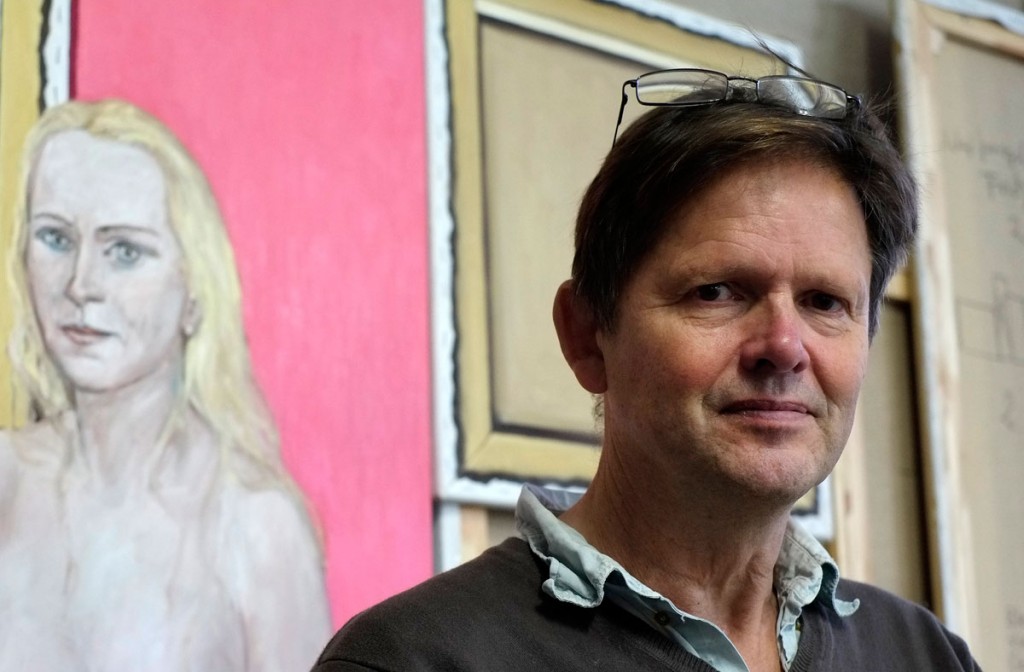Icelandic painter Helgi Thorgils Fridjonsson was born in Budardalur in 1953. He studied at the Icelandic Academy of Arts and Crafts and at De Vrije Academie, Den Haag and Jan van Eyck Academie, Maastrict in the Netherlands.
Since 1974 Helgi has been very active and regularly exhibits his work both in Iceland, Europe and the U.S.A. To name a few, he partook in the Biennale de Paris in France in 1980, Thick Air, Fodor Museum in Amsterdam 1983, exhibitied at the XLIV La Biennale di Venezia, Italy in 1990, Prospect ´93 in Frankfurt, Germany in 1993 and Confronting Nature at the Corcoan Gallery of Art in Washington D.C. in 2002. This year Helgi´s work has so far been exhibitied in Italy, Germany and Iceland.
Since 1980, Helgi has run a small showroom, The corridor, in Reykjavík. His aim is to get new, foreign artists to exhibit their work in Iceland.
Five Crucifixions, Clouds and Marble
I was just about to finish the painting FIVE CRUCIFIXIONS, which I had been working on for two years, when the vignette writer Armann Reynisson came over to discuss a book cover that I was doing for his book 88 Stories Around Iceland. He was caught by the 8-metre-long painting and immediately said it would be great to see this painting in Hallgrimskirkja. I really hadn´t thought much about where I would exhibit this piece –I rarely do- but I liked the idea and contacted Hordur Askelsson, the cantor of Hallgrimskirkja, who was right away pleased with the idea. Hence, my collaboration with Hallgrimskirkja Friends of the Arts Society took off.
The painting FIVE CRUCIFIXIONS is part of a series of pictures based on the work of the old masters, self-portraits that in reality reflect the person looking at the painting. The concept being that the work flows from the spectator through the painter and from there into the story itself. A monotonous, cloudy sky forms the background and the crosses form a geometric structure. Whether the work should be regarded as religious, is really up to the spectator, however all mental conflict is by nature religious. People ponder the suffering of the crucified but I do not believe that for a religious person passion stands for direct pain, but rather for a kind of experience and motion in time. The painting, like religion, is just as relevant to modern, 20th century painting as it is to history. Both are interwoven with the existence of man.
In this context I use the word man for both men, women and culture.
I painted CLOUDS for the 1000 Years of Christianity celebrations in Thingvellir in the year 2000. The painting was hung on the cliffs next to Oxararfoss waterfall and the idea was that the spray from the waterfall would become part of the work, symbolising the eternal circulation and that ever since St. John consecrated the water, all water is in fact holy. The inspiration for the work comes from the blue ceiling in the church which supposedly connects heaven and earth. I wanted to connect the spectators with the sky and to the hidden world of dwarves and elves etc.
The work MARBLE is made specifically for this exhibition, like most of the work. They are paintings on canvas, showing sculptures. The doors framing them symbolise dimensions that open and close. The marble is heavy and static, as opposed to the light movements of the doors. The idea of an opening and closing door, even if it is static, suggests the power of motion but the motion itself lies in the rotation of the Earth. That is how performance is connected our ideas of the world.
All works in the exhibition are in one way or another in connection with these contemplations.

